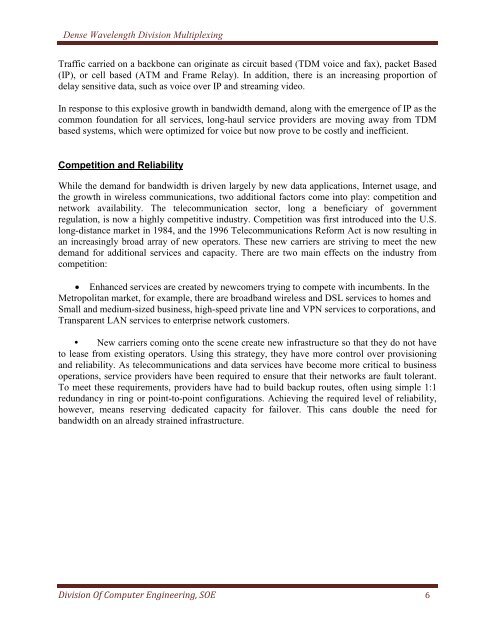Dense Wavelength Division Multiplexing - DSpace at CUSAT ...
Dense Wavelength Division Multiplexing - DSpace at CUSAT ...
Dense Wavelength Division Multiplexing - DSpace at CUSAT ...
You also want an ePaper? Increase the reach of your titles
YUMPU automatically turns print PDFs into web optimized ePapers that Google loves.
<strong>Dense</strong> <strong>Wavelength</strong> <strong>Division</strong> <strong>Multiplexing</strong><br />
Traffic carried on a backbone can origin<strong>at</strong>e as circuit based (TDM voice and fax), packet Based<br />
(IP), or cell based (ATM and Frame Relay). In addition, there is an increasing proportion of<br />
delay sensitive d<strong>at</strong>a, such as voice over IP and streaming video.<br />
In response to this explosive growth in bandwidth demand, along with the emergence of IP as the<br />
common found<strong>at</strong>ion for all services, long-haul service providers are moving away from TDM<br />
based systems, which were optimized for voice but now prove to be costly and inefficient.<br />
Competition and Reliability<br />
While the demand for bandwidth is driven largely by new d<strong>at</strong>a applic<strong>at</strong>ions, Internet usage, and<br />
the growth in wireless communic<strong>at</strong>ions, two additional factors come into play: competition and<br />
network availability. The telecommunic<strong>at</strong>ion sector, long a beneficiary of government<br />
regul<strong>at</strong>ion, is now a highly competitive industry. Competition was first introduced into the U.S.<br />
long-distance market in 1984, and the 1996 Telecommunic<strong>at</strong>ions Reform Act is now resulting in<br />
an increasingly broad array of new oper<strong>at</strong>ors. These new carriers are striving to meet the new<br />
demand for additional services and capacity. There are two main effects on the industry from<br />
competition:<br />
Enhanced services are cre<strong>at</strong>ed by newcomers trying to compete with incumbents. In the<br />
Metropolitan market, for example, there are broadband wireless and DSL services to homes and<br />
Small and medium-sized business, high-speed priv<strong>at</strong>e line and VPN services to corpor<strong>at</strong>ions, and<br />
Transparent LAN services to enterprise network customers.<br />
• New carriers coming onto the scene cre<strong>at</strong>e new infrastructure so th<strong>at</strong> they do not have<br />
to lease from existing oper<strong>at</strong>ors. Using this str<strong>at</strong>egy, they have more control over provisioning<br />
and reliability. As telecommunic<strong>at</strong>ions and d<strong>at</strong>a services have become more critical to business<br />
oper<strong>at</strong>ions, service providers have been required to ensure th<strong>at</strong> their networks are fault tolerant.<br />
To meet these requirements, providers have had to build backup routes, often using simple 1:1<br />
redundancy in ring or point-to-point configur<strong>at</strong>ions. Achieving the required level of reliability,<br />
however, means reserving dedic<strong>at</strong>ed capacity for failover. This cans double the need for<br />
bandwidth on an already strained infrastructure.<br />
<strong>Division</strong> Of Computer Engineering, SOE 6

















